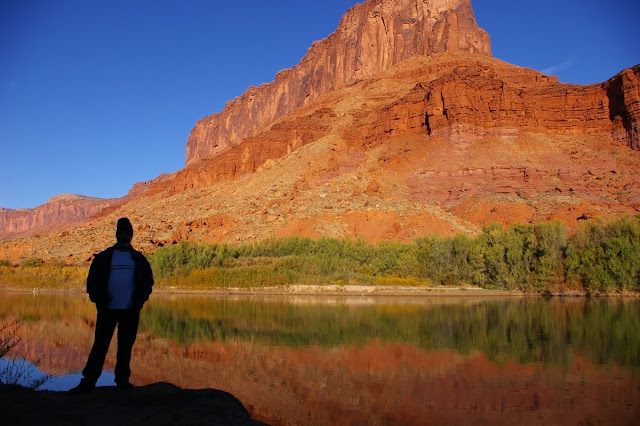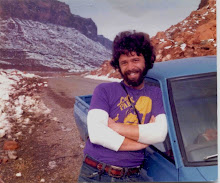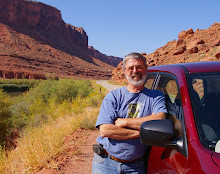It’s 7 o’clock on Christmas morning. The house is still asleep. Outside a milky blue glow to the east silhouettes the trees and telephone poles. No snow this year. Just an icy stillness beyond the windows. I am the first one up, as always, so I have already played Santa and stuffed the stockings that now hang distended from the mantle. In a few hours all the packages underneath the tree will have been opened, their wrappings scattered about for the cat to play with. But for now, there is a look of perfection, a kind of symmetry in all the squares, rectangles and oddly shaped bundles under the tree.
Thursday, December 31, 2020
Christmas 2020
Friday, December 4, 2020
The Skylight
Several nights a month the full moon pokes its opal colored dome over the Grand Mesa, and slowly ascends into the Colorado night sky, losing both its warm hue and imposing size along the way. As it rises ever higher, it gradually floats over Mantey Heights, sending milky shafts of light through the skylight in our bathroom. Depending upon the time of year and the moon’s position in the sky, the light will slide down along the wall and into our bathtub or it may tickle our towel rack before reaching the floor. For a few hours, it becomes a celestial night light both calming and intriguing, and I look forward to its arrival every month.
I know it is all reflected light from the sun and I can appreciate the science of it all. But mostly I can be grateful for that skylight where, for a few hours every month, I can capture pieces of that rather holy moonlight, and make it my own
Friday, November 13, 2020
Riding the Steel Bronco
Aside from a few commuter train rides from Los Altos to
San Francisco, the first real train trip that I ever took was from Thompson,
Utah to Oakland, California. It was
early January of 1975. Three months
earlier I had accepted a park ranger job in the Needles District of Canyonlands
National Park and I was determined to take my live-in partner Susan with
me. This time we would pretend to be man
and wife to avoid the quickie Reno marriage that I had endured as a very naïve
seasonal ranger several years before. In
October, 1974, we left our home in the Salinas Valley with Susan driving her
old VW bus, while I wrangled the small U-Haul truck with my Datsun pickup
hooked to a tow bar in the rear.
We had determined to head to southern California first to
retrieve some of Sue’s belongings before sequestering ourselves in the canyon
country. All went relatively well until
we got to Santa Barbara. I noticed that
the U-Haul was driving erratically and when I pulled over to check it out, I
was appalled to find out that somehow the Datsun had jack-knifed into the tow
bar which had impaled itself to the Datsun’s front bumper.
As fate would have it, we were rescued by a young mechanic in a nearby
garage who separated said vehicles, but that left us with three vehicles to
deal with and only two drivers. Realizing our dilemma, the mechanic told us we
could leave the Datsun with him and pick it up at our convenience. So, taking a huge leap of faith, we left my little
pickup with a complete stranger in Santa Barbara, and continued on to
Canyonlands.
By early January we had made arrangements to take the
train back to California to retrieve my truck.
By that time, my friend Tom Ferrell had gone down to Santa Barbara on
his own, rescued the Datsun, and had driven it back to Pinnacles where he was
stationed. These were the days before
AMTRAK. Our only option was to pick up
the Steel Bronco, the northbound Denver & Rio Grande passenger train in
Thompson, Utah, and make a couple of transfers to get us to our
destination. My district ranger Dave
Minor dropped us off at the snowy platform in Thompson. We were the only two people there when the
train pulled in late in the afternoon.
It was the dead of winter and the cold night was only
minutes away. Sue and I were riding
coach, of course, so we sat side by side sharing a blanket over our legs,
watching as the hulking Bookcliffs turned into a long, jagged silhouette
outside of Green River, then disappeared entirely. But we looked upon it all as
just another romantic adventure. We had
only been living in Canyonlands for a few months, and already the sublime
isolation and magic landscape had won us over.
We were feeling a little naughty as she gave me a hand job under the
blanket as we rolled along. We got to
Ogden, Utah just before midnight and had to get off the train and board a bus
to Salt Lake City where we picked up another west bound train around 1am. I slept fitfully feeling cold drafts whenever
anyone entered our car. I remember
waking up in Elko, Nevada and seeing snow falling. But eventually we made it all the way to the
bay area, got a ride down to Pinnacles, and retrieved my much-missed Datsun
pickup, which was not too much the worse for wear.
After a day or two of visiting friends, we began the
drive back to the Needles. I’m not sure where we slept that first night but I
remember going through Cove Fort, Utah very late the following night with snow
falling. Only a few pieces of Interstate 70 were complete so we were on and off
of frontage roads most of the way, but happily reached our destination with two
vehicles now at our disposal and a weird little adventure behind us. After all
these years, I still love the sound and the feel of a train rumbling through
the dark desert night as the steel rails rock me to sleep, and the mysterious
darkness beckons.
Thursday, August 27, 2020
And Then There Was Elizabeth
And then there was Elizabeth. She was part of a San Francisco State poetry group that would meet at our little house on Geary Street back in 1969. I was 22 and she was 30. I was smitten almost immediately. And somehow, we ended up together. I had only lost my virginity about a month previous, and was feeling sexually inept but she was pretty and pretty patient with me and not at all aggressive. She hung out with a fascinating group of people, all of them nearly a decade older than me, and some of them holdovers from the beat generation. Most of them were into poetry and music.
Another time I joined her and her friends for a day at the beach, somewhere down near Santa Cruz. It was a pretty intimidating group, and I mostly just hung out with them and smoked dope, and listened to their conversation, much of it political.
Tuesday, August 4, 2020
Bud's Books
Bud
Kalette owned one of the oldest book stores in Carson City, Nevada. Books & Antiques was housed in the bottom
floor of an old Victorian on Curry Street, which rumor had as a former brothel. For many years, he was also my sister Elenie’s
landlord for her vintage clothing shop, Revelations, which was located several
blocks away in the same old neighborhood, dotted with Arts & Crafts
bungalows and stately Victorian homes.
Bud’s store straddled the abrupt dividing line between the Sierra Nevada
range just a few blocks away, and the Great Basin desert splaying out into an
infinite eastern horizon.
To
the south, past Minden and Gardnerville, the road comes alive through places
like Bridgeport where Robert Mitchum
starred in the noir classic Out of the Past, and Lee Vining, the
gateway to Yosemite. And just beyond
that the tufa-studded shoreline of Mono Lake.
Bud had a fantastic collection
of Western Americana, everything from books about Death Valley to the history
of San Mateo County, California and the development of cable cars in the
west. He also had drawer upon drawer of
antique postcards, the old hand tinted variety, carefully cataloged and arranged.
I ended up with a huge stack of
hard-to-find titles, mostly regional tomes like a history of Inyo County and
Memories of the Mendocino Coast. I
really could have looked for much longer but I wasn’t sure I could afford to do
it. As it turned out, when I went to
cash out, Bud’s sister charged us a pittance to carry it all off.
But the most priceless part of
the experience was having the silence, the solitude and the time to just look
to our hearts’ content, to graze through the piles of paper. In the dim lower floor of an historic home.
With no pressure to buy. No crowded
aisles. But surrounded by the most
wonderful array of written material one could imagine. If I could have, I would have spent the night
gladly on that hard wooden floor with all those books as my companions. But eventually, like waking up from a
blissful dream, we had to emerge into the harsh desert light and the white heat
of reality.
Thursday, July 30, 2020
The First Time
Sunday, June 14, 2020
Petroglitch
Monday, May 25, 2020
Last Time in Little Spring
 And that
was after a full bore drive down highway 211, passing cars at every opportunity
in hopes of finding a site. It helps to
have driven this road three or four hundred times over the years, knowing every
curve and canyon, recognizing individual cottonwood trees and petroglyph
panels. It begins at Church Rock
junction with a long open stretch through overgrazed grass and sagebrush, the
long climb to abandoned Ogden Center and through Photographers Gap, then down
toward the drainage from Harts Draw and the flanks of the Abajo Mountains. The section down the Dugway is steep and
curvy and used to be treacherous in the winter months. A few errant ponderosas have taken root in
the Navajo sandstone. Just beyond the
switchbacks Indian Creek flows in from the south to give the canyon its name
and character.
And that
was after a full bore drive down highway 211, passing cars at every opportunity
in hopes of finding a site. It helps to
have driven this road three or four hundred times over the years, knowing every
curve and canyon, recognizing individual cottonwood trees and petroglyph
panels. It begins at Church Rock
junction with a long open stretch through overgrazed grass and sagebrush, the
long climb to abandoned Ogden Center and through Photographers Gap, then down
toward the drainage from Harts Draw and the flanks of the Abajo Mountains. The section down the Dugway is steep and
curvy and used to be treacherous in the winter months. A few errant ponderosas have taken root in
the Navajo sandstone. Just beyond the
switchbacks Indian Creek flows in from the south to give the canyon its name
and character.The Art of Campfire
 I have become quite adept over the years at
making good campfires. I am not talking
about the big, blazing “white man” fires one often sees in campgrounds, but the
quiet little fire that flares and flits around two, maybe three logs....large
enough to warm the hands but not so large as to drive one away with smoke and
heat. I have started fires under some of
the most extreme conditions in past times.
There was the little fire I got going when Phil and I holed up in a cave
at Canyonlands during a snow flurry. No
paper and not much wood. Just a bit of
juniper bark and some twigs, but that was enough. Then there was the time in Little Spring
Canyon when Cindy and I got caught in a major rain storm
and had visions of being flash-flooded down into the Colorado River. But I led us to a large alcove that I had
remembered and we found enough downed wood to get a fire going and make a sweet
little campsite. And the canyon never
did flood.
I have become quite adept over the years at
making good campfires. I am not talking
about the big, blazing “white man” fires one often sees in campgrounds, but the
quiet little fire that flares and flits around two, maybe three logs....large
enough to warm the hands but not so large as to drive one away with smoke and
heat. I have started fires under some of
the most extreme conditions in past times.
There was the little fire I got going when Phil and I holed up in a cave
at Canyonlands during a snow flurry. No
paper and not much wood. Just a bit of
juniper bark and some twigs, but that was enough. Then there was the time in Little Spring
Canyon when Cindy and I got caught in a major rain storm
and had visions of being flash-flooded down into the Colorado River. But I led us to a large alcove that I had
remembered and we found enough downed wood to get a fire going and make a sweet
little campsite. And the canyon never
did flood.









